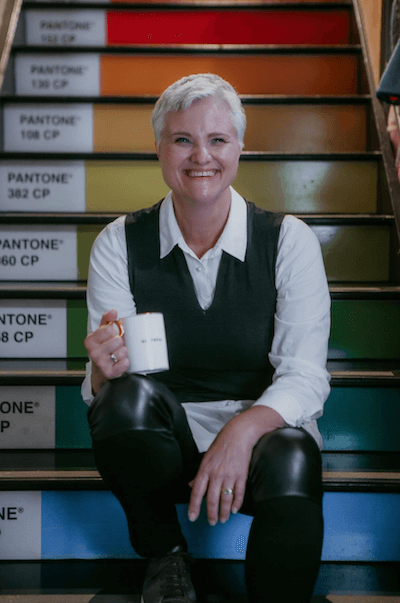Hey fabulous clinicians in private practice,
I want to say a MASSIVE thank you to everyone who has been in touch with me after last week’s blog post. It’s always so encouraging to receive comments and emails or private messages from people who are inspired to take action following something you’ve written.
(I don’t know about you, but often I write blog posts or any piece of content really and wonder, is anyone going to take any notice?… which very quickly spirals into self doubt and the sense that I have nothing to say. Not the point of this post but I thought you might like to know that I deal with these feelings too. A lot.)
Judging from your responses, one of the biggest sticking points for us is finding somewhere to start. Even when the recommendation was seemingly a simple one, to find some part of your business where you can change one thing that will result in an exponential change for the good, is hard.
Knowing where to start can be overwhelming.
It seems that we like to get tangled up in choosing the one thing to start with.
Hey there, perfectionist. I see you.
It’s interesting to think about why we find it hard to start. As clinicians we are often very risk-averse. We spend all day thinking about mitigating risk for our clients, after all. We live in a risk management framework, often thinking 3 or 4 steps ahead of where our clients are right now to come up with all the contingency plans they might need. While we’re very good at being present and in the moment with our clients, many of us are already planning the next 3-4 sessions ahead making sure that the progress we are seeing is real and integrated.
Think about this for a moment…
A mental health professional might see up to 6 clients in a day.
- Client #1 comes in to discuss ongoing addiction issues, and how these are impacting his relationships and his capacity for work. In session you are checking in with him to make sure he is safe, the people around him are safe and that his job is safe.
- Client #2 comes in to work on her generalised anxiety, which has been triggered by recent news events. In session you are ensuring she has the skills and capacity to be able to leave session today and be safe.
- Client #3 comes in needing to discuss an abusive relationship. In session you are all about creating the plan for safety and security for your client.
- Client #4 arrives to explain he is terminating today. This is a surprise and one that you do not recommend. You spend the session discussing the pros and cons of remaining in treatment with a genuine concern for what if things go wrong for this person and who can he turn to?
- Client #5 is a new client, your entire session is rapport building and fact finding – until they disclose that they have thoughts of self harm. Your risk management skills go into overdrive.
- Client #6 is a sweet man that you have been working with for years. He arrives with red-rimmed eyes, and immediately starts crying. Sobbing, loudly and uncontrollably. What has happened what is going to happen; how do I hold this space; what do I need to be aware of and mindful of?
See? Managing risks at every turn.
How about the OT who also sees 5 clients in a day?
- Client #1: assessment for walking aides; how do I hep my client avoid falling while maintaining her independence, oh my… look at that welt on the side of her leg, maybe that’s an infection?
- Client #2: review of memory aides for young man with acquired brain injury, who somehow manages to arrive for the session but has forgotten to bring his smart phone, his diary and his therapy folder with him – you are wondering what else he is forgetting as it appears he has not washed in a while.
- Client #3 arrives 30 minutes early and does not appear to be able to sit still or stay focused in the waiting room. You find you need to move her to the lunch area and are concerned about her being left unsupervised.
- Client #4 arrives with his parents, this was unexpected. Oh this can’t be good. Parents coming unannounced to a session with an adult client is never a good sign.
- Client #5 arrives with a note book full of homework. So much homework, wonder where she had the time to complete all of that… you discover that this is the first time she has left the house in 10 days and she has not attended school to complete her homework for you.
So – we tend to operate from a risk management framework. Can you see this now, how all day in sessions with clients you are supporting their progress while helping them to manage risks. Now risks are not bad. In fact we all need to take risks, otherwise we would not grow or change.
This is why we as clinicians tend to find it difficult to know where to start. We are actually so scared of getting it wrong, of not getting it right (they are not the opposite if each other by the way), of wondering if this thing I chose is the right thing, what if it meant to be that thing; what if I choose to start working on my finances when I really need to be working on my marketing?
What If I start making change and it doesn’t work? What then? What if I’m supposed to do it the same way as Mary, Alice, Bob and Peter (random names people I am not referring to anyone here).
Is it any wonder we don’t like starting!!!! Look at all the things that could go wrong.
And if things go wrong, oh look out, what does that say about me as a person
I’m a failure
I’m not good enough
I need to go and get a job?
Risk Managing is the paradox for the entrepreneurial clinician. We don’t operate from a risk taking framework, but that is what is required of us as an entrepreneur.
So if you are like so many clinicians in private practice who get tied up and bound up by not knowing where to start or even how to start, do not fear. You are not alone, it is this very fact that quite possibly sets you apart as an excellent clinician.
The GOOD news however is, we get to decide on the size of the risk!
Here is an example of what someone in this fabulous community has committed to after last week’s post. Yes I have her permission to share this with you, and no you don’t need to know who it is – but she and I thought this might be a great way to help someone else know where to start:
“Here’s my response, and to be honest, I wanted to keep listing them, buy as you say let’s just start with OnE!!!
THE most important thing that I can do for my private practice- today!!!…..
–> What’s the problem?
I don’t have an up to date budget; expenses in particular
–> What makes it a problem?
I put it off because I know that my income isn’t as high as I’d love it to be & it depresses me to crunch the data and see where I am NOT at in terms of financial health
–> Why is it worth fixing?
Because it means I’m unclear of my financial position, and I’m not clear of how I’m tracking with spending in relation to earning.
–> How will I fix it?
Do my budget- write up and calculate expenses vs income
–> What one small step can I take today to move a tiny bit closer towards fixing that problem?
Place in my diary when I can set aside 1 hour to start it, and another hour within 3 days of that to finish it!!! Then stick to it and do it!
And diarize when, fortnightly, I will keep track of my spendings & earnings.”
What a tremendous example of how just choosing one thing (and I know this thing scares this person) and committing to simple yet powerful action from the choice.
So I am going to ask this question again….
What is ONE THING you can commit to, that you know will bring about a massive accumulative change to your Practice and more importantly to you?
Looking forward to hearing what you choose and reading your plan of action.
ABOUT JO
Jo Muirhead is a Rehabilitation Counsellor with over 20 years of experience in vocational rehabilitation, and a mentor to allied health professionals who are ready to make freedom, flexibility and fulfilment happen in 2016 and beyond.
Click here to get the first workbook in the series created exclusively for clinicians in private practice: Why Goal Setting Doesn’t Always Work (and how to make it easier).



